
Landscaping with Kids: How to Combine Plants and Parenting
Include children in landscaping activities to create new bonding experiences and teach them lifelong skills. Start small, be patient, and focus first on having fun. In this blog we look at age-appropriate landscaping tasks for toddlers, school-age kids, and middle- and high-schoolers.
Ask any parent and they’ll likely tell you that raising children is simultaneously a source of joy and an ongoing challenge. Kids push boundaries, learn to say “no” very early, and sometimes have very strong preferences. But they’re also full of energy and have an insatiable desire to explore the world around them.
One of the difficulties of parenting is spending quality time with kids while still accomplishing day-to-day tasks and chores around the house. In this post, we suggest a few ways to include children in your landscaping activities.
Start Small
First, remember that every child is different. Some are passionate about caring for plants and animals, and some would rather just play in the dirt.
If you are inviting your child to join you in a landscaping activity, consider tackling age-appropriate tasks in small blocks of time. As your child becomes more accustomed to landscaping work, you may be able to extend the time and expand the breadth of projects.
As your child expresses interest in certain tasks or specific aspects of a project, let him or her join in just for that part. The middle-school boy might like showing off his strength as he wheelbarrows mulch across the yard but then tire quickly of spreading it, while a young girl might prefer weeding to tree trimming.
Allowing your kids to only participate in an enjoyable part—at least at first—will help open their minds to enjoying new activities.
Assign Age-Appropriate Tasks
Children see the world differently than adults. Many times, just being in proximity to a project is enough for them to feel that they have contributed to it and accomplished something exciting.
Toddlers and Preschoolers
These young ones thrive with tactile tasks. Pouring water, rubbing their hands in the soil, or carrying small tools to and from the worksite creates a sense of responsibility and instills the joy of exploration.
School-Age Kids
Once out of toddlerhood, children can handle more complex tasks with several steps. They may be able to open a bag of fertilizer and spread small amounts around a specific area or help check stalks for bug infestations. Whatever the task, it should be fun!
Middle and High Schoolers
Older children are capable of completing most tasks with supervision and basic direction. There may be other challenges with these age groups, such as technology distractions or convincing them to join you outside before noon on a Saturday. Consider leaving cell phones inside (for parents and kids!) and landscaping in the late afternoon.
Embrace the Long-Term Vision
A child’s fine motor skills, attention span, and ability to follow multi-step instructions will increase and improve over time.
We have found that keeping the long-term goal in mind—to cultivate a strong relationship with our kids and help them appreciate the earth—helps suppress the frustration that may surface from time to time. When pots get overturned or flowers are accidentally lopped off, a deep breath and an encouraging word to your child goes a long way.
If you want to do landscape chores quickly and efficiently, do them alone. If you want to create a bonding activity that the family enjoys together, be patient and embrace the mess.